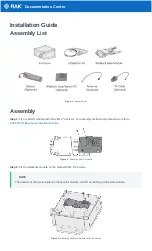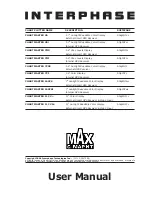
Page 12
12.0 ESE TEST RESULTS
The methods mentioned in section 11 are conclusions based upon actual tests performed by ESE and on
information provided by various manufacturers. The performance of your unit may differ due to antenna
position and obstructions to its line of sight, weather/atmospheric conditions, cable length or signal reflections.
Listed below are the "best" consistent performances. That is, they were repeatable performances on a
consistent basis... not just fluke observations.
Caution is recommended: as the GPS Satellites age, their signal strength may decrease and today's cable
length could cause undesirable results at a later date.
The ESE factory conducted several tests which demonstrate how the ES-185U/GPS Antenna can be expected
to operate for given sets of circumstances. All tests were conducted at ESE (in El Segundo, CA) in 1998 and
due to the architecture of the GPS Satellite Constellation, can be considered applicable most anywhere in the
world.
12.1 Test 1
The first test shows that up to 112' of RG-58 cable can be added to the 16’ 5” without any significant loss
in signal. (Adding 125' impaired the clock's performance.)
12.2 Test 2
When using a single LA-12F, in-line amplifier with 150' of RG-58 cable (in addition to the 16’ 5” supplied),
the clock would "lock-on" in a nominal amount of time. (Adding 175' impaired the clock's performance.)
12.3 Test 3
Using an ES-AB1A (power divider) and two (2) LA-12F with 100' of RG-58 cable attached to each (216’
5” total) permitted the clock to "lock-on" in a nominal amount of time. Adding a third LA-12F with 75' of
RG-58 cable did not impair the clock's performance, however, increasing the 75' to 100' did impair the
clock's performance.
12.4 Test 4
Using an ES-AB1A (power divider) and four (4) LA-12F with 75' of RG-58 cable attached to each (316’ 5”
total) permitted the clock to "lock-on" in a nominal amount of time. Adding a fifth LA-12F with 25' of RG-58
cable also permitted the clock to "lock-on" in a nominal amount of time. Increasing the 25' to 50' impaired
the clock's performance.
All of the tests mentioned above were conducted twice; first with the antenna indoors and second with the
antenna outdoors. (Indoors refers to the ESE factory which is a single story building with a wood ceiling
and asphalt composite roofing. And outdoors, the antenna had a very narrow look at the sky with
approximately six feet of clearing between buildings.)
In all cases, the ES-185U "Locked-on" within fifteen minutes, and in less time when the antenna was
outside. ("Locked-on" refers to starting the clock from a completely "powered down" mode and the nine-
digit display "catching" real-time with the "GPS Lock" LED lit.)
Various tests conducted away from the factory show that the exact unit which took five minutes to lock-on
at the factory, may take up to 45 minutes at a different location. Possible explanations for this
phenomenon lead us to believe that atmospheric conditions or poor antenna locations may be
responsible.
Summary of Contents for ES-185U
Page 21: ...This page is not available with online manual requests and was intentionally left blank ...
Page 22: ...This page is not available with online manual requests and was intentionally left blank ...
Page 23: ...This page is not available with online manual requests and was intentionally left blank ...
Page 24: ...This page is not available with online manual requests and was intentionally left blank ...











































